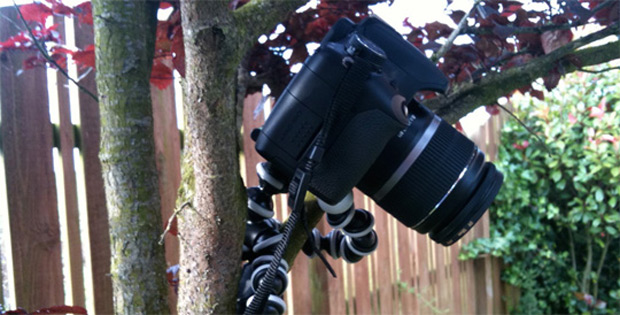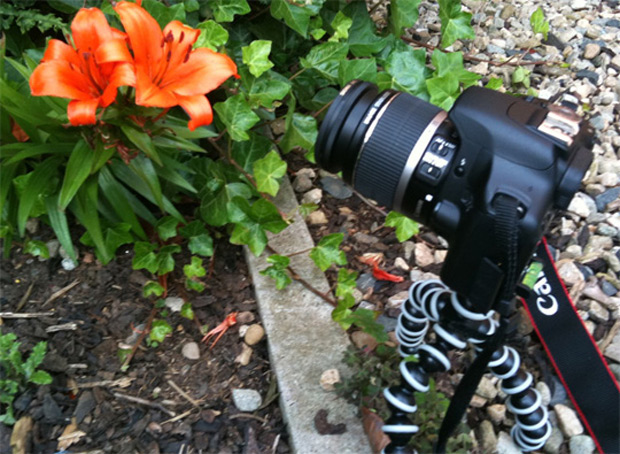It is difficult to miss the boom in the consumer digital SLR market, in additional to the iPhone these cameras currently dominate flickr (see the graphs). Recent releases boast 15 megapixel sensors and high definition video all with the ability to interchange lenses offering endless possibilities for the budding photographer. Check out this macro hi-def videocaptured with Canon’s new 500D. Over the last few days I have been playing with probably the best birthday / christmas present any photographer could receive, the Joby Gorillapod SLR. Yes I risked my prized 500D (mini review) so you don’t have to !
Initially I have to admit I was a little scared attaching what is a reasonably heavy camera to something as unusual as the Gorillapod but it was quick to see how strong and robust this mini tripod actually is. Balance the camera with the three very bendable legs and the Gorillapod will lock in that position perfectly.

Initially I used the tripod on fixed levels such as the floor or desktop so that if it did fall I wasn’t taking too much of a risk but within a few hours I was discovering creative applications as to just where the camera could be located, most of them a little risky. (See the photos for a few examples).
Macro Photography
Having dabbled in a range of different photography techniques, for me the most enjoyable has to be macro photography. A little like the later example of animation I have been using my tripod to overlook a table on which the item being photographed is placed.
The annoyance comes with prime fixed focused lenses and actually getting in close enough to the item to actually photograph it properly.

(The photo taken in the above setup is on flickr although it wasn’t the prime lens attached at the time which took this photo).
The Gorillapod offers a perfect solution. The flexible tripod can be easily slid along the surface of the table and locked into position for photographing via remote shutter release. The camera height and level can easily be easily adjusted my bending the legs of the Gorillapod, this is particularly relevant when shooting nature macro.
The mini tripod folds down small enough to fit into most camera bags and the screw in fixing (for the camera) is small enough to be left on at all times. In use the gorillapod can be fixed to just about anything.
I admit initially I was a little nervous hanging my prized 500D from large heights but within a few hours my confidence in the Gorillapod’s ability to look after my camera had me hanging it from all sorts of trees, fences and gates.
Even on those occasions when a tripod really isn’t necessary the gorillapod offers quite useful additional support and frees up both hands to work with the item being photographed or with additional equipment.
The fact that digital SLR cameras now offer the ability to record high definition video the gorillapod becomes even more an essential part of every photographers kit bag.
Animation & Education
In the education setting the Gorillapod range again offers a practical alternative to bulky tripods. The mobile version would be perfect for use with Flip video devices (read our review), we are using these more and more in the classroom situation as the perfect video solution.
Claymation (or stop motion) animation is a popular technique in Moving Image Arts education. Students painstakingly make sets and models and bring them to life frame by frame.
One of the biggest problems facing students is camera set access. Most of the animation work is produced using an Macbook Pro and the iStopmotion animation software. Students use external light sources to illuminate their set and to date the camera has been placed on a standard tripod overlooking the desk and set.
The Gorillapod is going to become an essential tool in the animation process in the years ahead. It offers close access within a production set as well as being fully adjustable to various height levels. The following photo shows the spirit level in use, a better view is available on Flick, click here).

The inbuilt spirit level offers additional guidance and the fact the Gorillapod remembers its shape really well so the daring animator could risk marking the feet locations and move the camera out of set between adjustments.
I think it is fair to say the device is going to have a very positive input into final claymation films and we will certainly be experimenting with the device for capturing traditional rostrum animation work.
Gorillapod isn’t just the realm of the SLR market, a number of other models exist for compact and even high end video cameras. Without doubt this is the best mini tripod we have used (and we have used quite a number).
At around £30 pounds for the digital SLR version, function, portability and ease of use make this as an essential as a camera bag when it comes to any photographers kit bag. There is even a dedicated Flickr group for photos taken with the support of a Gorillapod.
SevenbyFive ????
Gorillapods are also excellent as an alternative to a light stand for off camera flash. I use them extensively for portraits and dig it out of the bag at weddings as well.
Haven’t had the opportunity to try one yet but they look like they could come in very handy in certain situations. After reading your excellent article I’m definitely going to stop procrastinating and go buy one!
I actually never thought about using it as a flash stand, that would be a perfect application for the gorillapod, thanks David.
I do like my GorillaPod SLR zoom, and sometimes use it as a shooting platform. Although it is strong enough in a pinch to hold my 20D + battery grip, it isn’t an ideal solution for heavier cameras like the 20/30/40/50D or 5D etc. I suspect it would just not be able to hold any of the EOS1 series. It’s great for the lighter bodies in the Rebel line, and decent for the midrange models without a battery grip.
What I use it for all the time though is as a flash mount. It makes a fantastic way to mount a flash anywhere, and is far more stable than the little feet or other small flash tripods/stands that I’ve used. Not a replacement for an actual light stand, but much more portable, and a flash stand you have is much more useful than the one you left at home.
I have both the SLR and SLR Zoom. Like others here I use them more often as stand/grip for hot shoe flashes. If you want stability, go for the “next size up” for the entire range. I found the SLR won’t reliably hold my A900 no matter what lens I have mounted, but it is FANTASTIC for my G11. SLR Zoom holds A900 adequately with smaller lenses, but put on a 24-70 2.8 or 70-200 2.8? Fuggedaboutit.